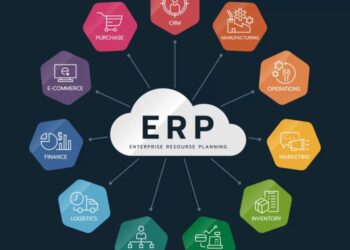Delve into the world of ERP RFP and discover the crucial role it plays in software selection. Uncover the key components, best practices, and evaluation strategies that make an ERP RFP successful.
Introduction to ERP RFP
An ERP RFP, or Enterprise Resource Planning Request for Proposal, is a formal document that organizations use when looking to purchase an ERP software system. This document Artikels the requirements, needs, and criteria that the organization is seeking in an ERP solution, and it is sent out to potential software vendors for them to respond with their proposed solutions.
Importance of an ERP RFP
Creating an ERP RFP is crucial in the software selection process as it helps organizations clearly define their needs and expectations. By outlining specific requirements and criteria, the ERP RFP ensures that vendors understand what the organization is looking for and can tailor their proposals accordingly.
This process helps in comparing different vendor offerings objectively and making an informed decision based on the organization's specific needs.
Components of an ERP RFP
- Introduction: Provides an overview of the organization and the purpose of the RFP.
- Background: Details the current state of the organization, including challenges and goals.
- Scope of Work: Artikels the specific requirements and functionalities needed in the ERP system.
- Vendor Information: Requests details about the vendor's experience, expertise, and proposed solution.
- Selection Criteria: Defines the evaluation criteria that will be used to assess vendor proposals.
- Timeline: Specifies the deadlines for submission, evaluation, and selection.
Key Sections of an ERP RFP
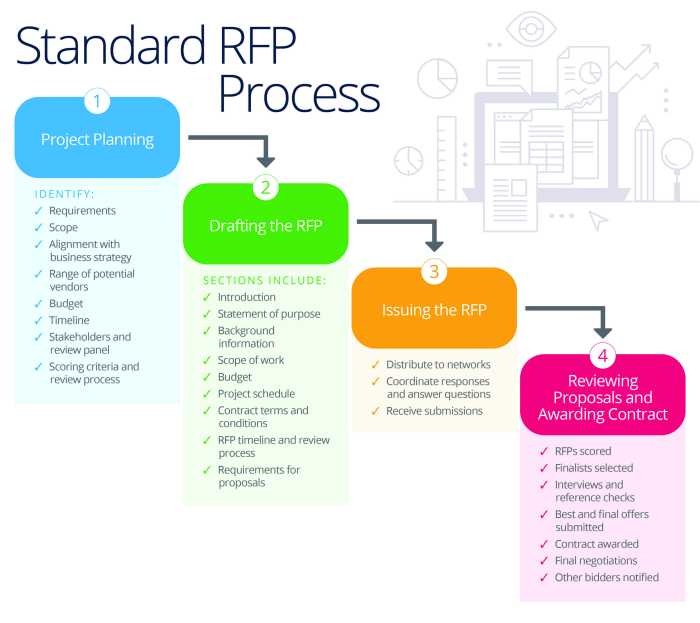
When creating an ERP Request for Proposal (RFP), there are several key sections that should be included to ensure all necessary information is provided to potential vendors. Each section serves a specific purpose in the overall document and helps in evaluating vendor proposals effectively.
1. Introduction
The introduction section sets the stage for the RFP by providing an overview of the organization, its goals, and the purpose of the ERP project. This section also Artikels the scope of the RFP and any specific requirements that vendors must address in their proposals.
2. Project Scope and Objectives
In this section, the organization details the scope of the ERP project, including the specific objectives that need to be achieved. This helps vendors understand the goals of the project and tailor their proposals accordingly.
3. Functional Requirements
The functional requirements section Artikels the specific features and functionalities that the organization expects from the ERP system. This could include modules for finance, HR, supply chain, etc. Vendors need to address how their solution meets these requirements.
4. Technical Requirements
The technical requirements section specifies the IT infrastructure, integration capabilities, data migration needs, and other technical aspects that the ERP system must meet. Vendors must provide details on how their solution aligns with these requirements.
5. Implementation Plan and Timeline
This section focuses on the implementation approach proposed by vendors, including timelines, milestones, and resource allocation. It helps in evaluating the vendor's understanding of the project and their ability to deliver within the specified timeframe.
6. Pricing and Licensing
The pricing and licensing section details the cost structure of the ERP solution, including initial implementation costs, ongoing maintenance fees, and licensing terms. This allows the organization to compare pricing models and choose the most cost-effective option.
7. Vendor Qualifications and Experience
In this section, the organization requests information about the vendor's qualifications, experience, references, and any certifications they hold. It helps in evaluating the vendor's credibility and ability to successfully deliver the ERP project.
Examples of ERP RFP Structures:
- Company A structures their ERP RFP with a detailed project scope, followed by a breakdown of functional and technical requirements, implementation plan, pricing, and vendor qualifications.
- Company B includes an executive summary at the beginning of their RFP, followed by sections on project objectives, system requirements, implementation approach, pricing, and vendor experience.
Best Practices for Creating an Effective ERP RFP
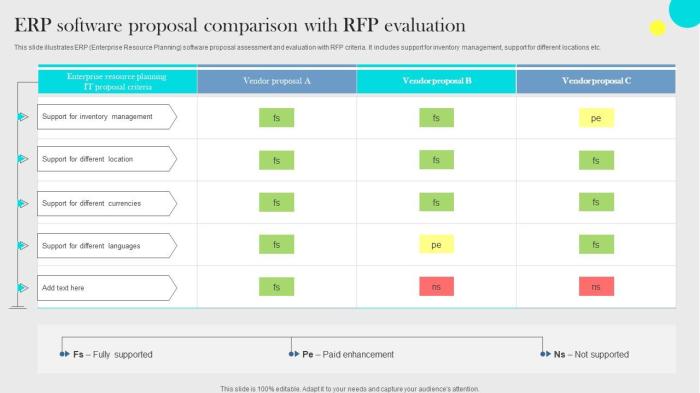
When creating an ERP RFP, it is essential to follow best practices to ensure a successful outcome. Here are some strategies to consider:
Gathering Requirements Before Drafting an ERP RFP
Before drafting an ERP RFP, it is crucial to gather requirements from key stakeholders within the organization
. This can be done through interviews, surveys, and workshops to ensure that all needs and expectations are captured accurately.- Engage with different departments to understand their unique requirements and pain points.
- Create a cross-functional team to gather diverse perspectives and insights.
- Document all requirements in a clear and organized manner to serve as the foundation for the ERP RFP.
Ensuring Clarity and Specificity in an ERP RFP
Clarity and specificity are paramount when creating an ERP RFP to avoid any confusion or misinterpretation. Here are some tips to achieve this:
- Use clear and concise language to communicate requirements and expectations.
- Avoid ambiguous terms or jargon that may be misunderstood by vendors.
- Include specific details such as timelines, deliverables, and performance metrics to set clear expectations.
Aligning the ERP RFP with the Organization’s Goals and Objectives
To create an effective ERP RFP, it is essential to align it with the organization's overarching goals and objectives. Here's how you can ensure alignment:
- Review the organization's strategic plan to understand key priorities and initiatives.
- Ensure that the ERP RFP reflects the organization's long-term vision and objectives.
- Communicate the expected outcomes and benefits of the ERP implementation to vendors to align their proposals with the organization's goals.
Evaluating ERP RFP Responses
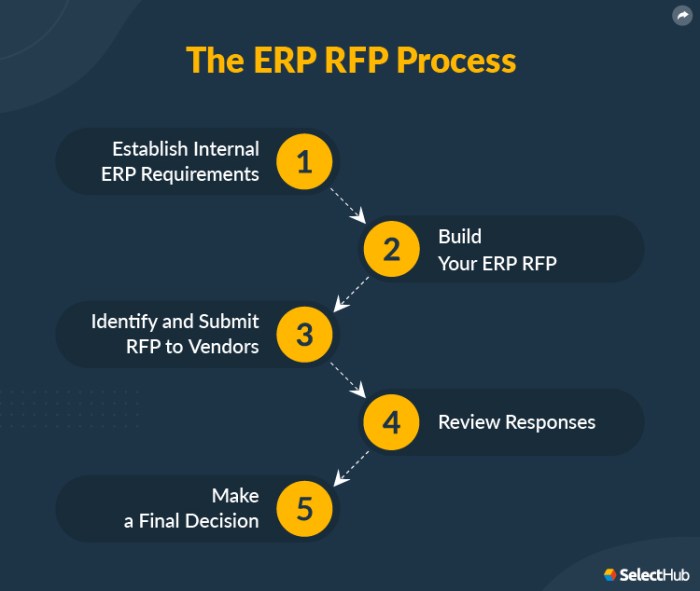
When it comes to evaluating responses to an ERP RFP, it is crucial to have a systematic process in place to ensure a thorough assessment of vendor proposals. This involves considering various criteria and utilizing scoring models or frameworks to make informed decisions.
Process of Evaluating ERP RFP Responses
Once the responses to the ERP RFP are received, the evaluation process typically involves the following steps:
- Reviewing each proposal carefully to understand the vendor's approach and offerings.
- Comparing the proposals against the requirements Artikeld in the RFP document.
- Scoring the proposals based on predetermined criteria to objectively assess each vendor.
- Conducting vendor presentations or meetings to clarify any questions or concerns.
- Making a final decision based on the evaluation results and selecting the vendor that best meets the organization's needs.
Criteria for Assessing Vendor Proposals
When assessing vendor proposals in response to an ERP RFP, some common criteria to consider include:
- Alignment with the organization's business objectives and requirements.
- Technical capabilities and scalability of the proposed ERP solution.
- Vendor experience and reputation in the industry.
- Cost and pricing structure of the proposed solution.
- Quality of support and maintenance services offered by the vendor.
Scoring Models for Evaluating ERP RFP Responses
There are various scoring models or frameworks that can be used to evaluate ERP RFP responses. One common approach is the weighted scoring model, where different criteria are assigned weights based on their importance. Another method is the balanced scorecard, which considers both financial and non-financial aspects of the vendor proposals.
Organizations may also develop custom scoring models tailored to their specific needs and priorities.
Last Word
In conclusion, mastering the art of creating an ERP RFP is essential for any organization seeking the right software solution. By following the best practices and guidelines Artikeld here, you can streamline your selection process and make informed decisions.
Clarifying Questions
What is an ERP RFP?
An ERP RFP (Request for Proposal) is a document that Artikels the requirements and criteria for selecting an Enterprise Resource Planning system.
How can I ensure clarity in an ERP RFP?
To ensure clarity, make sure to use precise language, avoid jargon, and provide detailed explanations for each requirement.
What are some common criteria for evaluating ERP RFP responses?
Common criteria include cost, functionality, vendor stability, scalability, and alignment with organizational goals.

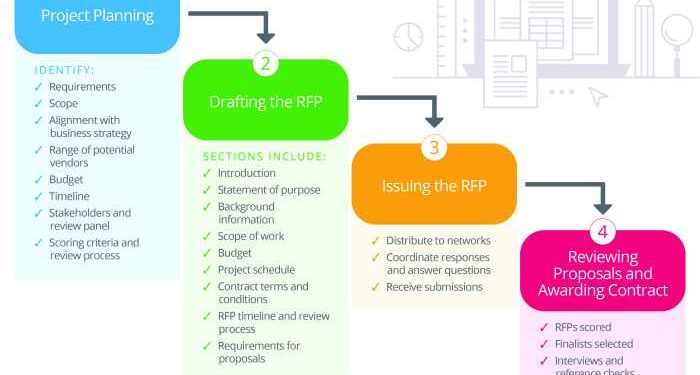






![Best Construction ERP Software [2024 Edition]](https://health.bandungnews.id/wp-content/uploads/2025/10/Top-10-Best-Construction-ERP-Software-to-Use-in-2024-1-120x86.jpg)


